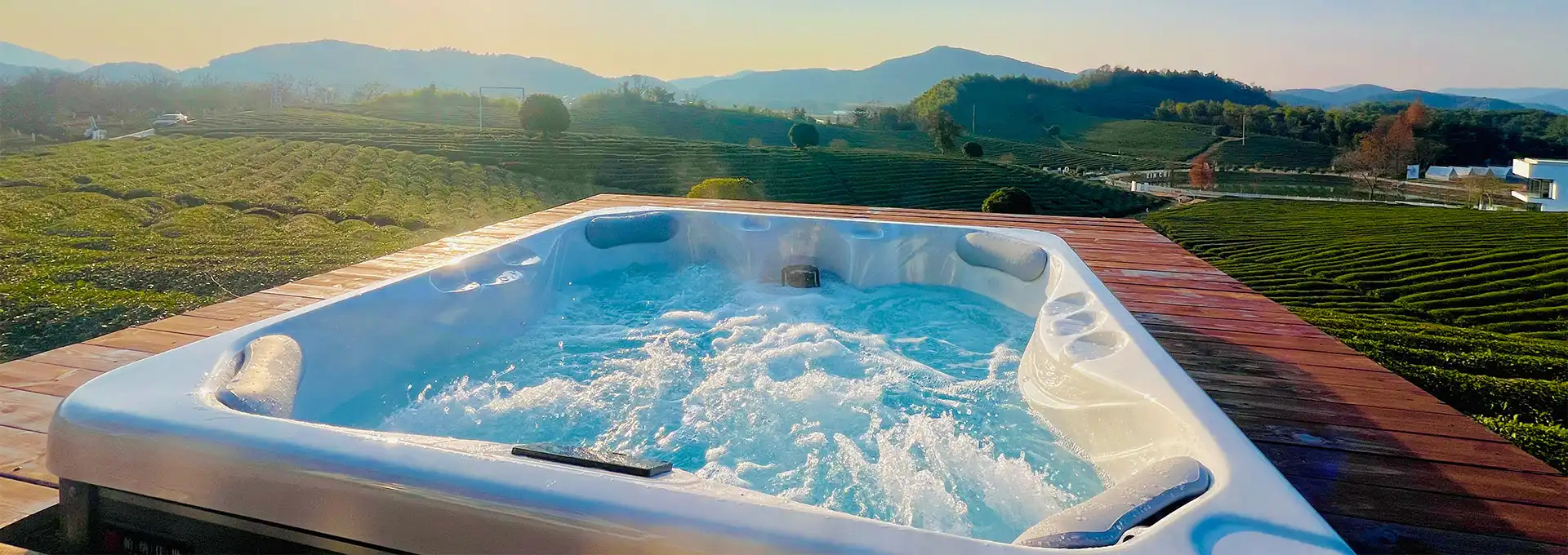Can You Have a Salt Water Swim Spa?
2024-10-15 16:42:37
Salt water swim spas are gaining popularity as an alternative to traditional chlorine-based systems. These innovative pools combine the benefits of a swimming pool and a hot tub, using salt water chlorination to maintain water quality. This article will explore salt water swim spas, their advantages, and how they compare to conventional options. We'll also address some common questions about large capacity hot tubs that can accommodate up to 8 people.
What are the benefits of an 8-person hot tub?
An 8-person hot tub offers numerous advantages for homeowners looking to enhance their outdoor living space and promote relaxation and social gatherings. These larger capacity spas provide ample room for family and friends to enjoy together, making them ideal for entertaining or hosting intimate gatherings.
One of the primary benefits of an 8-person hot tub is its versatility. With multiple seating options and jet configurations, these spas can accommodate various preferences and body types. Some models feature lounge seats for full-body relaxation, while others offer bench seating or cool-down areas. This variety ensures that everyone can find their perfect spot to unwind and enjoy the therapeutic benefits of hydrotherapy.
The increased size of an 8-person hot tub also allows for more advanced features and amenities. Many models include powerful jet systems that target different muscle groups, providing a full-body massage experience. Some spas incorporate water features like fountains or waterfalls, adding visual appeal and soothing ambient sound to enhance the overall atmosphere.
Energy efficiency is another advantage of larger hot tubs. While they may require more water and energy to heat initially, their larger volume helps maintain temperature more consistently than smaller models. This can result in lower operating costs over time, especially when combined with high-quality insulation and energy-efficient pumps and heaters.
For those who enjoy aquatic exercise, an 8-person hot tub can double as a small exercise pool. The extra space allows for low-impact activities like water aerobics or resistance training, providing a well-rounded wellness solution in one compact package.
Lastly, investing in a larger hot tub can increase your property's value and appeal. A well-maintained 8-person spa can be an attractive feature for potential buyers if you ever decide to sell your home, setting your property apart from others on the market.
How does a salt water system work in a swim spa?
A salt water system in a swim spa uses a process called electrolysis to generate chlorine from dissolved salt, providing a more natural and gentle approach to water sanitation. This innovative technology has gained popularity in recent years due to its numerous benefits and ease of maintenance.
The heart of a salt water system is the chlorine generator, also known as a salt cell or salt chlorinator. This device contains electrically charged metal plates that convert salt (sodium chloride) into chlorine through electrolysis. As water passes through the salt cell, the electrical current breaks down the salt molecules, releasing free chlorine ions into the water.
To start the process, pool-grade salt is added to the swim spa water. The amount of salt required is relatively low, typically around 3,000 to 4,000 parts per million (ppm), which is about one-tenth the salinity of seawater. This low concentration means the water doesn't feel or taste overly salty, but it's enough to fuel the chlorine generation process.
As the chlorine sanitizes the water by neutralizing contaminants and killing bacteria, it eventually reverts to salt. This creates a continuous cycle where the salt is constantly being reused, reducing the need for frequent chemical additions. The system maintains a consistent chlorine level, typically between 1 and 3 ppm, which is sufficient for effective sanitation without the harsh effects often associated with traditional chlorine treatments.
One of the key advantages of a salt water system is its ability to produce softer, more comfortable water. Many users report that the water feels silkier on their skin and is less likely to cause eye and skin irritation compared to conventionally chlorinated water. This can lead to a more enjoyable and relaxing swim spa experience.
Maintenance of a salt water swim spa is generally simpler and less time-consuming than traditional chlorine systems. While you'll still need to monitor and adjust pH and alkalinity levels, the need for frequent chlorine additions is eliminated. Instead, you'll only need to add salt occasionally to replenish what's lost through splashing or water replacement.
It's important to note that while salt water systems reduce the need for chemical handling, they don't eliminate it entirely. You may still need to shock the water periodically or add other balancing chemicals to maintain optimal water chemistry. However, the overall chemical usage is typically lower than in traditional chlorine systems.
What is the ideal temperature for a swim spa?
The ideal temperature for a swim spa can vary depending on its intended use and personal preferences. Unlike traditional swimming pools, which are usually kept cooler, swim spas offer the flexibility to adjust temperatures for different activities and seasons.
For general swimming and exercise, many users find that a temperature range of 80-85°F (26-29°C) is comfortable. This range allows for vigorous activity without overheating, while still providing some warmth for comfort. The cooler end of this range is often preferred by serious swimmers or those engaging in more intense workouts, as it helps prevent overheating during extended periods of exercise.
If you plan to use your 8-person hot tub for relaxation and hydrotherapy, you might prefer slightly warmer temperatures. A range of 90-95°F (32-35°C) is often ideal for soaking and enjoying the therapeutic benefits of warm water. This higher temperature range can help soothe sore muscles, improve circulation, and promote relaxation.
During colder months or for evening use, some swim spa owners may choose to increase the temperature to around 98-100°F (37-38°C). This creates a more hot tub-like experience, perfect for unwinding after a long day or enjoying a warm soak on a chilly night.
It's important to note that the maximum recommended temperature for a swim spa is typically 104°F (40°C). Temperatures above this can pose health risks, especially for prolonged exposure or for certain individuals with health conditions.
When using your swim spa for multiple purposes, consider a model with separate zones or the ability to quickly adjust temperatures. Some advanced swim spas offer dual-temperature zones, allowing you to maintain a cooler area for swimming and exercise while keeping another section warmer for relaxation.
The ideal temperature can also depend on factors such as age, health status, and pregnancy. Children, elderly individuals, and pregnant women may need to use lower temperatures or limit their time in the water. Always consult with a healthcare professional if you have any concerns about safe water temperatures for your specific situation.
Energy efficiency is another consideration when setting your swim spa temperature. Maintaining a consistently high temperature can increase energy costs, especially in colder climates. Some swim spa owners choose to keep their spa at a lower base temperature and increase it only when they plan to use it for relaxation or therapy.
Conclusion
Salt water swim spas offer a unique and enjoyable aquatic experience, combining the benefits of a swimming pool and a hot tub in one versatile package. With the added advantage of salt water chlorination, these spas provide a more natural and comfortable environment for swimming, exercising, and relaxing. Whether you're looking for a spacious 8-person hot tub for entertaining or a temperature-controlled swim spa for year-round use, these innovative systems can enhance your home and promote overall well-being. As technology continues to advance, salt water swim spas are likely to become an increasingly popular choice for homeowners seeking a low-maintenance, eco-friendly, and luxurious water feature for their outdoor living space.
For more information on hot tub installations and to find out more about our products, please feel free to contact us at info@iparnassus.com.
References:
1. Swim University: "Salt Water Hot Tubs: Pros, Cons & How They Work"
2. SwimEx: "Salt Water vs Chlorine Swim Spas: Which is Better?"
3. Hydropool: "The Benefits of Salt Water Hot Tubs"
4. Bullfrog Spas: "8 Person Hot Tubs: The Ultimate Guide"
5. Master Spas: "What is the Best Temperature for a Swim Spa?"
6. Endless Pools: "Salt Systems for Swim Spas: What You Need to Know"
7. Hot Spring Spas: "Salt Water Hot Tub Systems: Pros and Cons"
8. PDC Spas: "The Advantages of Large Capacity Hot Tubs"
9. Aqua Magazine: "Salt Chlorine Generators for Spas"
10. Pool Research: "Salt Water Pool Systems: Costs, Designs & More"
Send Inquiry
Related Industry Knowledge
- Can a Heart Patient Get in a Hot Tub?
- Is It Worth Buying a Swim Spa?
- What Happens When a Swim Spa Loses Heat?
- Does Hot Tub Water Kill Grass?
- How to repair spa control panel?
- How Can Outdoor Swim Spas Be Used for Muscle Recovery?
- How Heavy is a 4 Person Hot Tub
- How Often Should My Swim Spa Filter Run?
- How Much Does a 6 Person Hot Tub Weigh Empty?
- Are Outdoor Hot Tubs Going Out of Style?



